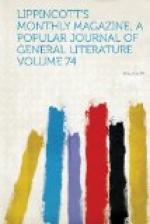“The first time we ever travelled second-class in our lives,” murmured Materfamilias.
“I too,” responded the cheeky Bohemian.
Another difference between Dean Bohemianism and Continental is characteristic of the whole race whose land this is. Whereas artists in France, Italy, and Germany are of gregarious habit and gather for their summers in rural inns, where they form a community by themselves, the Dean artist sets up his own vine and fig-tree and has a temporary home, if ever so small and mean. The farm-houses and cottages of the Dean are filled with lodgers, all dining at separate tables and living as aloof from each other as the true Briton always lives. There are advantages in this aloofness, but it certainly lacks the camaraderie, the jolly good-fellowship, of those picturesque auberges and osterie where twenty or thirty of one calling are gathered together under one roof, meeting daily at table, where artistic criticism is pungent and free, artistic assistance ungrudging, tales of artistic experience and adventure racy, the atmosphere stimulative to the spreading out of every artistic theory possible to the sane and insane mind.
In one of these Continental auberges rough boards a foot in width ran in one unbroken line round the four sides of the salle-a-manger. These boards were perhaps hazily intended for seats, but their real office was to hold all the artistic rubbish—smashed color-tubes, broken stretchers, ragged canvases, discarded palettes, disreputable paint-rags and oil-tubes—the auberge possessed. But every sunset, as the stream of artists set in from forest and field, the boards came into other service. All the work of the day was ranged upon them along the wall, and while the painters sat at meat comment and criticism grew rampant, every canvas coming in for its share. That many good lessons were given and taken in this wise va sans dire. That also artistic progress was punctuated not unseldom with “betise,” “imbecile,” “nom du chien,” “you’re a goose,” and “you’re another,” goes equally without saying to all who know the unrestraint of artistic Bohemia and the usual attitude of the human mind under criticism.
The walls of this salle-a-manger were—and are—arranged with panels, in which messieurs les artistes exercised their skill. It is a marked peculiarity of these artistic communities that no branch of art is so popular as caricature. Sometimes these caricatures are amiable, sometimes the reverse. Thus, when a certain blithe widow was represented colossally upon the wall with a little man in her eye, the likenesses were so good and the truth of the caricature so palpable that the widow herself was moved to as quick laughter as the others. But when American Palmer worked all day upon a panel to create a sunny sea laughing radiantly back at a sunny sky, while fantastic lateen-sailed craft floated like bits of jewelled color between, it was mean, to say the least, of Scotch Willie to take advantage of the American’s departure and paint out those fairy boats, filling their places with horrible bloated corpses, floating upon the bright water like a nightmare upon innocent sleep.




